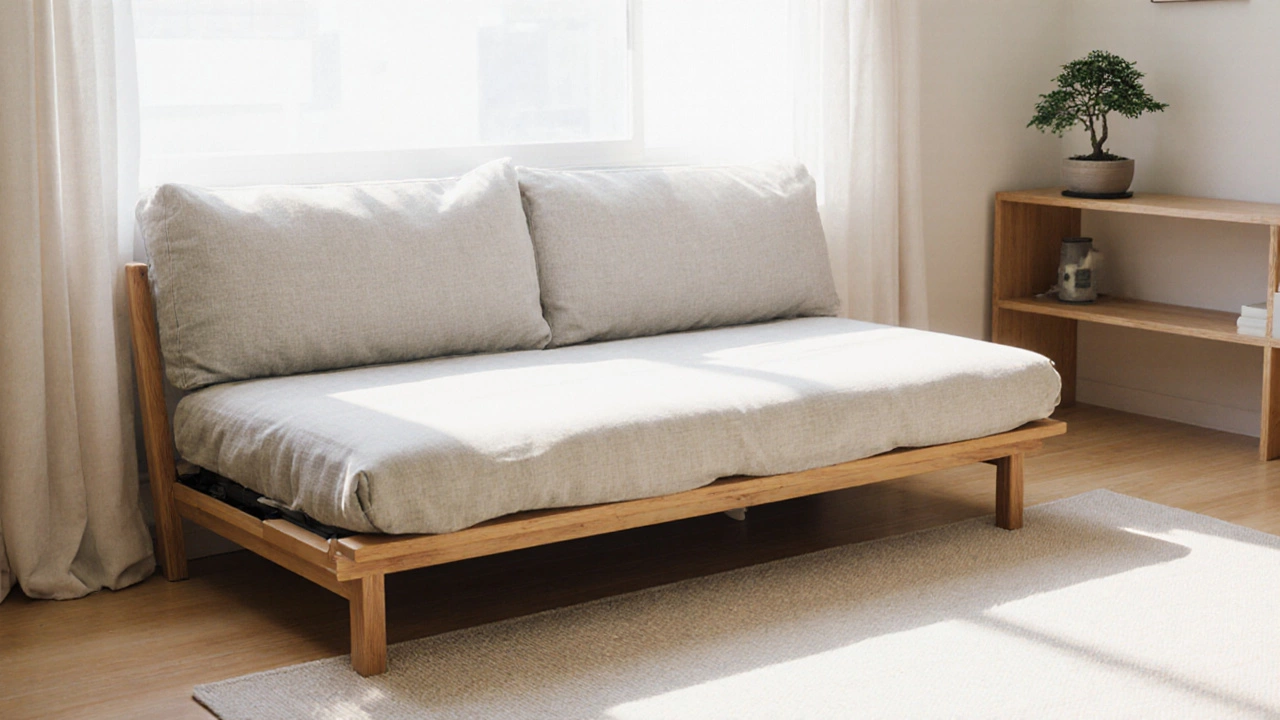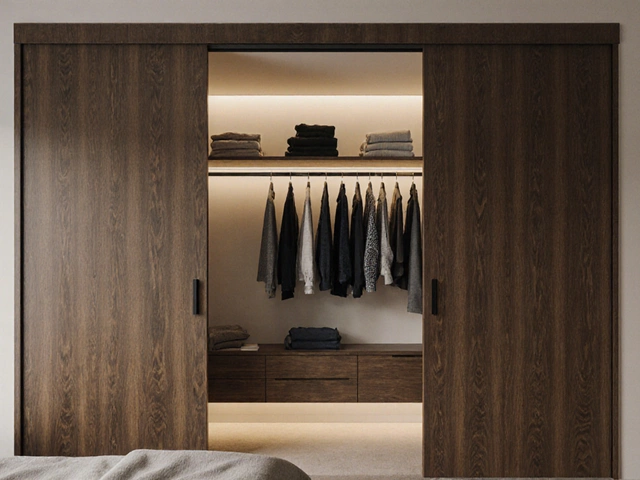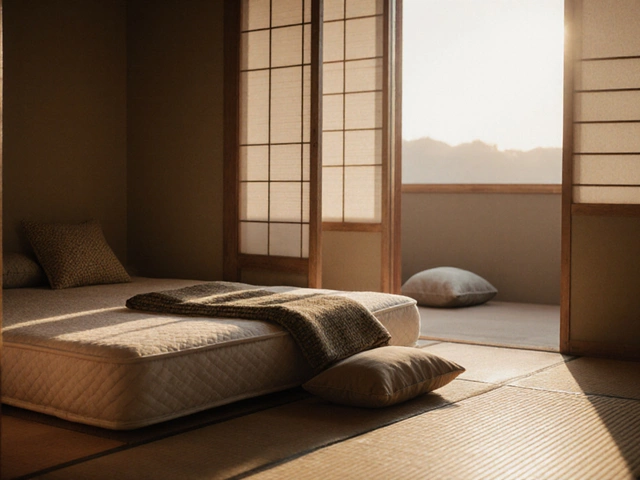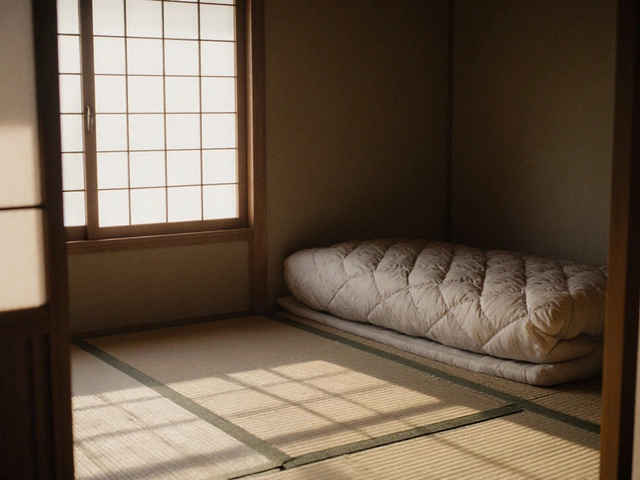Japanese Sofa Bed Comparison Tool
Use this tool to compare Japanese sofa beds with conventional Western sofa beds and floor futons. Select options below to see how they stack up:
Select options above and click "Compare" to see detailed feature comparisons.
Space-Saving Design
Low profile design (10-15 cm) allows it to blend seamlessly into modern living spaces without dominating the room.
Quick Conversion
Converts in just 2-3 seconds, perfect for guests or when you want to change the room layout quickly.
Minimalist Aesthetic
Clean lines and natural materials reflect Japanese minimalism, promoting calm and organized living spaces.
Supportive Sleep Surface
Thin but firm futon mattress provides excellent support for a restful night's sleep, ideal for occasional guests.
Ever spotted a low‑profile sofa that folds into a sleek bench and wondered what makes it so different from the bulky pull‑out couches you see in most living rooms? That’s a Japanese sofa bed - a piece that blends traditional Japanese comfort with modern space‑saving design. Below you’ll learn exactly what it is, why it’s gaining popularity outside Japan, and how to pick the right one for your home.
TL;DR - Quick Takeaways
- A Japanese sofa bed is a low, minimalist couch that folds flat to become a futon‑style sleeping surface.
- It uses a thin, firm futon mattress (often on a tatami‑grade base) for a supportive night’s sleep.
- Space‑saving mechanisms let you convert the piece in seconds, ideal for small apartments.
- Design focuses on clean lines, natural materials, and a Japanese aesthetic that promotes calm.
- When buying, consider mattress thickness, frame material, and how the sofa fits your layout.
What Exactly Is a Japanese Sofa Bed?
In its simplest form, a Japanese sofa bed is a Japanese sofa bed a low‑profile, modular couch that folds into a flat futon mattress, reflecting traditional Japanese sleeping arrangements while serving as a modern seating solution. Unlike Western pull‑out sofas that hide a thick, spring‑coiled mattress inside a bulky frame, the Japanese version stays close to the floor, echoing the way people in Japan traditionally slept on futons placed directly on tatami mats.
The key components are:
- A futon mattress a thin, firm sleeping pad typically 4‑6 inches thick, made from cotton, foam, or a blend, designed for nightly use that can be folded or rolled.
- A wooden or metal frame the supporting skeleton, often crafted from Japanese cedar, oak, or powder‑coated steel, engineered to pivot smoothly that doubles as a sofa back when upright.
- A tatami‑grade base a low, sturdy platform mimicking the feel of traditional tatami flooring, sometimes integrated into the frame for added stability that keeps the sleeping surface firm.
Because the design stays low to the ground, it aligns with Japanese minimalism a design philosophy that values simplicity, natural materials, and uncluttered spaces. The result is a piece that looks like a sleek bench by day and a comfortable bed by night.
How It Differs From Conventional Sofa Beds
If you’ve tried a western‑style pull‑out couch, you know the “awkward sleeper” problem - a thick mattress that sags, a noisy mechanism, and a bulky frame that dominates the room. The Japanese version tackles each issue:
| Feature | Japanese Sofa Bed | Western Sofa Bed | Floor Futon |
|---|---|---|---|
| Height from floor | 10‑15cm (low‑profile) | 30‑45cm (high back) | 4‑6cm (direct on floor) |
| Mattress thickness | 4‑6in (firm) | 8‑12in (soft) | 4‑6in (firm) |
| Conversion time | 2‑3seconds | 30‑60seconds | None (already a bed) |
| Space needed when closed | Bench‑like footprint | Large sofa footprint | None (stored in closet) |
| Design aesthetic | Minimalist, natural wood or metal | Varied, often plush upholstery | Simple, textile‑only |
Notice the Japanese sofa bed’s focus on a slim, supportive mattress and a rapid folding action. That makes it perfect for micro‑apartments, studio living, or anyone who wants a clean look without sacrificing a decent night’s sleep.
Key Design Elements to Look For
When you start browsing, keep an eye on these attributes:
- Mattress material: 100% cotton provides breathability, while a high‑density foam core adds durability. Some models blend both for a balance of softness and support.
- Frame construction: Solid hardwood (like Japanese cedar or oak) gives a warm aesthetic and can last decades. Powder‑coated steel offers a sleek modern look and resists denting.
- Mechanism type: Look for a hinge system that pivots at the centre rather than a sliding drawer; the hinge usually reduces noise and wear.
- Cover fabric: Natural linens or cotton blends echo traditional Japanese textiles and stay cool in summer. Avoid heavy plush that can trap heat.
- Footprint dimensions: Measure the cleared space when the sofa is upright. A typical Japanese sofa bed occupies about 180cm×80cm×15cm when closed.
Each of these fits within the broader space‑saving furniture pieces designed to maximize usable area by folding, stacking, or converting for multiple functions trend that has surged in dense urban markets across North America and Europe.
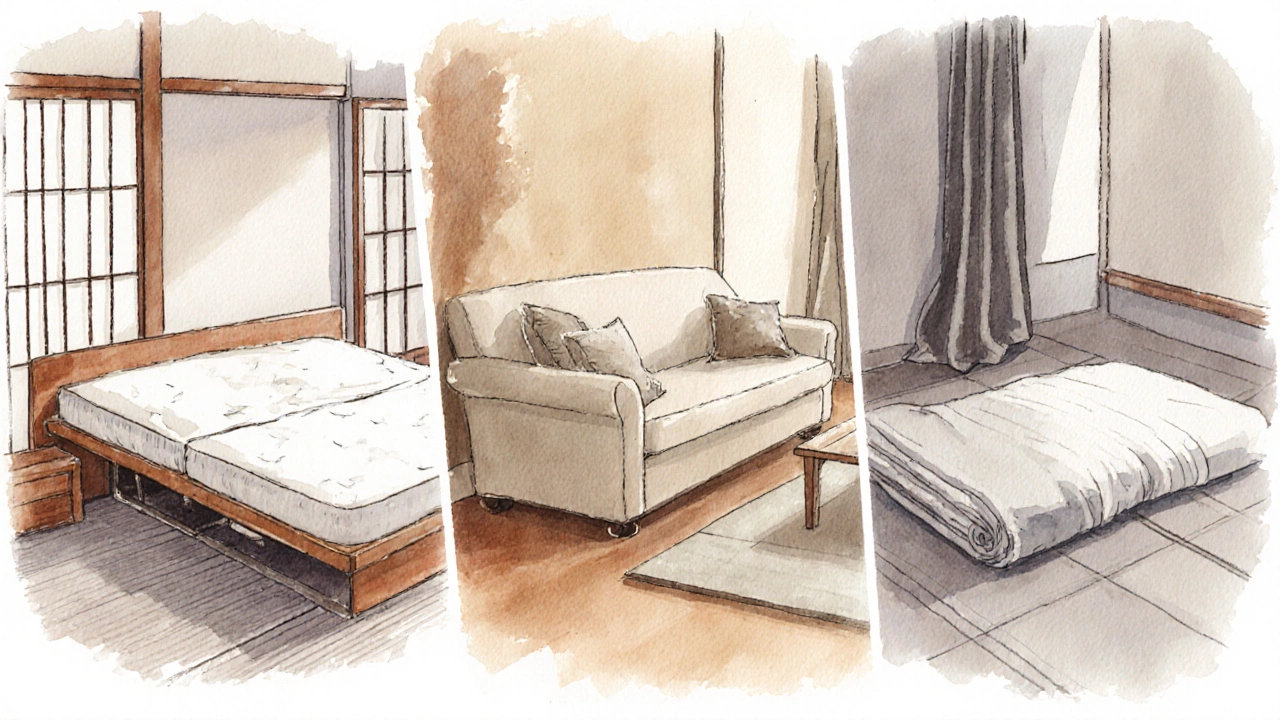
How to Choose the Right Japanese Sofa Bed for Your Home
Think of the buying process as a short quiz you run on yourself:
- Do you need a primary sleeping surface? If guests stay over frequently, prioritize a firmer futon (density >18lb/ft³) for better back support.
- How much floor space is available? Measure the area you plan to allocate; a compact 140cm width works for a studio, while a 200cm width suits larger rooms.
- What style resonates with you? Wooden frames blend well with natural décor and Japanese interiors; metal frames suit industrial lofts.
- Are you concerned about allergies? Look for organic cotton covers and hypoallergenic foam; avoid polyester blends that can harbor dust mites.
- What is your budget? Prices range from CAD500 for basic pine models to CAD2,000+ for premium cedar with custom upholstery.
Answering these questions narrows the field quickly and helps you avoid buyer’s remorse. Remember, a Japanese sofa bed isn’t just a couch - it’s a multi‑functional furniture an item that serves two or more distinct purposes, typically seating and sleeping that can also act as a room divider when placed against a wall.
Styling Your Japanese Sofa Bed in Real Homes
Here are three realistic set‑ups you can picture in your own living area:
- Tokyo‑Inspired Minimalist: Pair the sofa with a shoji screen a translucent sliding panel made of wood and rice paper, used to partition spaces subtly, a low coffee table of reclaimed bamboo, and a single potted bonsai. Keep accessories to a minimum - perhaps a black‑ink calligraphy print.
- Scandinavian‑Meets‑Japanese: Choose a light oak frame, layer a woven wool rug, and add a few throw pillows in muted teal. The neutral palette lets the sofa’s clean silhouette shine while creating a cozy Nordic vibe.
- Industrial Loft Adaptation: Opt for a powder‑coated steel frame with a dark grey linen cover. Place it against exposed brick, add a reclaimed wood coffee table, and use LED strip lighting along the ceiling for a modern twist.
In each scenario, the sofa’s low height encourages floor‑level seating - a habit found in many Japanese homes that promotes flexibility and a sense of openness.
Care and Maintenance Tips
Because the mattress is thinner than a typical couch, proper upkeep extends its life:
- Rotate the futon monthly. Flip it 180° to avoid uneven wear, especially if you use it nightly.
- Air it out weekly. Unfold the bed, stand it near a window, and let fresh air circulate to prevent moisture buildup.
- Spot‑clean the cover. Use a mild detergent and lukewarm water; avoid bleach which can degrade natural fibers.
- Check hinges quarterly. Tighten any loose screws and apply a silicone-based lubricant to keep the folding action smooth.
Following these simple steps ensures the sofa remains both a sleek seat and a supportive sleeper for years.
Frequently Asked Questions
Can a Japanese sofa bed replace a traditional mattress?
For occasional guests or studio living, a high‑density futon mattress (18‑20lb/ft³) provides adequate support and can serve as a primary bed for many adults. However, if you suffer from chronic back issues, a thicker, spring‑based mattress may be more comfortable.
Is the futon mattress too firm for hot sleepers?
Futon mats are typically firmer than Western cushions, which helps with airflow. Choosing a cotton cover and a breathable foam core improves cooling. Adding a lightweight, breathable duvet can also balance firmness with comfort.
Do I need a tatami mat underneath?
A tatami‑grade base isn’t mandatory, but it adds a slightly softer feel and protects flooring. If you place the sofa on hardwood, a thin plywood underlayment works well and keeps the low‑profile aesthetic.
How much can a Japanese sofa bed weigh?
A typical model with a wooden frame and 4‑inch futon weighs between 30‑45kg (66‑100lb). Metal‑frame versions can be lighter, often under 30kg, making them easier to move in tight apartments.
Is assembly required?
Most Japanese sofa beds arrive partially assembled - the frame is pre‑drilled and the hinges are pre‑installed. You’ll typically attach the futon pad and tighten a few screws. Expect 15‑30minutes of setup.
Next Steps - Turning Knowledge Into Action
Now that you know what a Japanese sofa bed is, how it works, and what to look for, here’s a simple plan:
- Measure the area where you plan to place the sofa - note both upright and folded dimensions. \n
- Decide your priority: sleep quality vs. aesthetic. Choose a firmer futon if nightly use is expected.
- Browse reputable retailers that specialize in Japanese or Scandinavian furniture. Compare frame material, mattress density, and warranty terms.
- Order a sample fabric swatch if possible. Feel the texture before committing.
- Schedule delivery with the retailer - many offer white‑glove service to set up and demonstrate the folding mechanism.
Follow these steps and you’ll end up with a piece that not only saves space but also adds a calm, purposeful vibe to your home.

